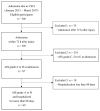Incidence and Risk Factors for Pneumonia in the Chronic Phase of Cervical Spinal Cord Injury with Complete Motor Paralysis
- PMID: 37636135
- PMCID: PMC10447191
- DOI: 10.22603/ssrr.2022-0254
Incidence and Risk Factors for Pneumonia in the Chronic Phase of Cervical Spinal Cord Injury with Complete Motor Paralysis
Abstract
Introduction: Pneumonia is one of the leading causes of acute- and chronic-phase mortality in patients with cervical spinal cord injury (CSCI) with quadriplegia. The risk factors for chronic-phase pneumonia recurrence in CSCI are still unknown. This study aimed to investigate the incidence of pneumonia in the chronic phase after injury and to identify its risk factors.
Methods: This retrospective clinical observational study included patients with CSCI with American Spinal Injury Association Impairment Scale grades of A or B admitted to our center within 72 h of CSCI injury who started treatment and were available for follow-up for at least 90 days. The patients were assessed for incidences of pneumonia and its associations with clinical characteristics, including risk factors at the time of injury. Patients in whom pneumonia developed within 30 days postadmission and those after 30 days of hospitalization were comparatively examined using univariate and multivariate analyses.
Results: Pneumonia occurred in 36% of the 69 enrolled patients throughout the study period and in 20% of all patients after 30 days of hospitalization. Multivariate analysis of risk factors for pneumonia showed that atelectasis (adjusted OR [aOR], 95% confidence interval [CI]: 4.9, 1.2-20.0), enteral feeding (aOR [95% CI]: 13.3 [3.0-58.9]), mechanical ventilation (aOR [95% CI]: 4.0 [1.0-15.0]), and tracheotomy (aOR [95% CI]: 14.6 [2.3-94.6]) within 30 days of admission were significantly associated with the occurrence of pneumonia even after 30 days of hospitalization.
Conclusions: The risk factors for developing pneumonia in the chronic phase were atelectasis, enteral feeding, mechanical ventilation, and tracheotomy within 30 days of hospitalization. This study suggests that treatment of atelectasis, long-term respiratory muscle rehabilitation, and training to improve swallowing function are essential to prevent the recurrence of pneumonia after 30 days of hospitalization.
Keywords: Cervical spinal cord injury; chronic phase; complete motor paralysis; pneumonia.
Copyright © 2023 The Japanese Society for Spine Surgery and Related Research.
Conflict of interest statement
Conflicts of Interest: The authors declare that there are no relevant conflicts of interest.
Figures

References
-
- DeVivo MJ, Kartus PL, Stover SL, et al. Cause of death for patients with spinal cord injuries. Arch Intern Med. 1989;149(8):1761-6. - PubMed
-
- Lemons VR, Wagner FC Jr. Respiratory complications after cervical spinal cord injury. Spine. 1994;19(20):2315-20. - PubMed
-
- DeVivo MJ, Black KJ, Stover SL. Causes of death during the first 12 years after spinal cord injury. Arch Phys Med Rehabil. 1993;74(3):248-54. - PubMed
LinkOut - more resources
Full Text Sources
